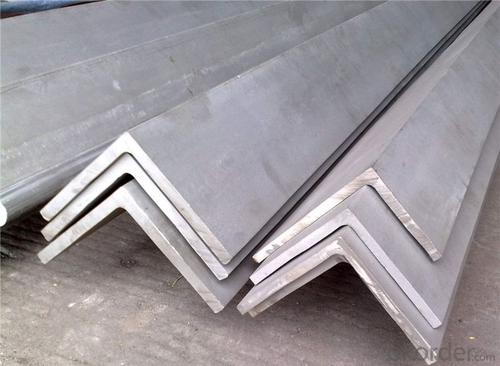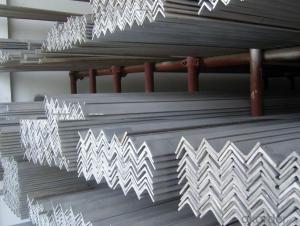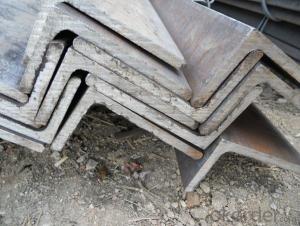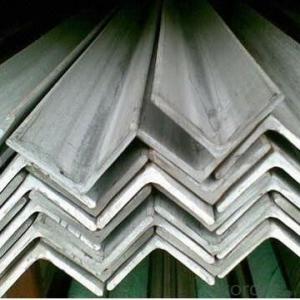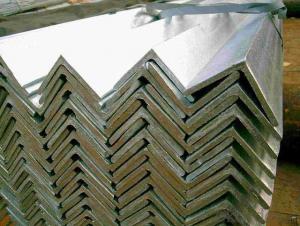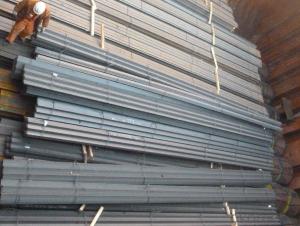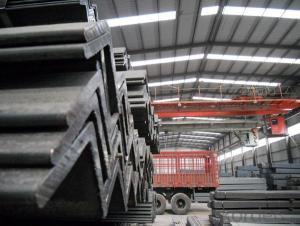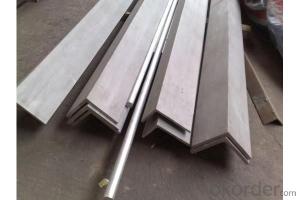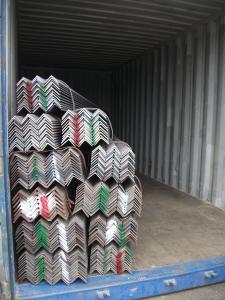Hot rolled sheet Equal Steel Angle bar EN10056
- Loading Port:
- Tianjin
- Payment Terms:
- TT or LC
- Min Order Qty:
- 25 m.t.
- Supply Capability:
- 100000 m.t./month
OKorder Service Pledge
OKorder Financial Service
You Might Also Like
Product Description:
OKorder is offering hot rolled sheet equal steel angle bar EN10056 at great prices with worldwide shipping. Our supplier is a world-class manufacturer of steel, with our products utilized the world over. OKorder annually supplies products to European, North American and Asian markets. We provide quotations within 24 hours of receiving an inquiry and guarantee competitive prices.
Product Applications:
Hot rolled sheet Equal Steel Angle bar are ideal for structural applications and are widely used in the construction of buildings and bridges, and the manufacturing, petrochemical, and transportation industries.
Product Advantages:
OKorder's equal steel angle bar are durable, strong, and resist corrosion.
Main Product Features:
· Premium quality
· Prompt delivery & seaworthy packing (30 days after receiving deposit)
· Corrosion resistance
· Can be recycled and reused
· Mill test certification
· Professional Service
· Competitive pricing
Product Specifications:
1. Invoicing on theoretical weight or actual weight as customer request
2. Length: 6m, 9m, 12m as following table
3. Sizes

Sizes: 25mm-250mm | ||
a*t | ||
25*2.5-4.0 | 70*6.0-9.0 | 130*9.0-15 |
30*2.5-6.6 | 75*6.0-9.0 | 140*10-14 |
36*3.0-5.0 | 80*5.0-10 | 150*10-20 |
38*2.3-6.0 | 90*7.0-10 | 160*10-16 |
40*3.0-5.0 | 100*6.0-12 | 175*12-15 |
45*4.0-6.0 | 110*8.0-10 | 180*12-18 |
50*4.0-6.0 | 120*6.0-15 | 200*14-25 |
60*4.0-8.0 | 125*8.0-14 | 250*25 |
5. Payment terms:
1).100% irrevocable L/C at sight.
2).30% T/T prepaid and the balance against the copy of B/L.
3).30% T/T prepaid and the balance against L/C
6.Material details:
Alloy No | Grade | Element (%) | |||||
C | Mn | S | P | Si | |||
|
|
|
|
|
|
| |
Q235 | B | 0.12—0.20 | 0.3—0.7 | ≤0.045 | ≤0.045 | ≤0.3 | |
|
|
|
|
|
|
| |
Alloy No | Grade | Yielding strength point( Mpa) | |||||
Thickness (mm) | |||||||
≤16 | >16--40 | >40--60 | >60--100 | ||||
≥ | |||||||
|
|
|
|
|
| ||
Q235 | B | 235 | 225 | 215 | 205 | ||
Alloy No | Grade | Tensile strength (Mpa) | Elongation after fracture (%) | ||||
Thickness (mm) | |||||||
| ≤16 | >16--40 | >40--60 | >60--100 | |||
≥ | |||||||
|
|
|
|
|
|
| |
Q235 | B | 375--500 | 26 | 25 | 24 | 23 | |
FAQ:
Q1: Why buy Materials & Equipment from OKorder.com?
A1: All products offered byOKorder.com are carefully selected from China's most reliable manufacturing enterprises. Through its ISO certifications, OKorder.com adheres to the highest standards and a commitment to supply chain safety and customer satisfaction.
Q2: How do we guarantee the quality of our products?
A2: We have established an advanced quality management system which conducts strict quality tests at every step, from raw materials to the final product. At the same time, we provide extensive follow-up service assurances as required.
Images:
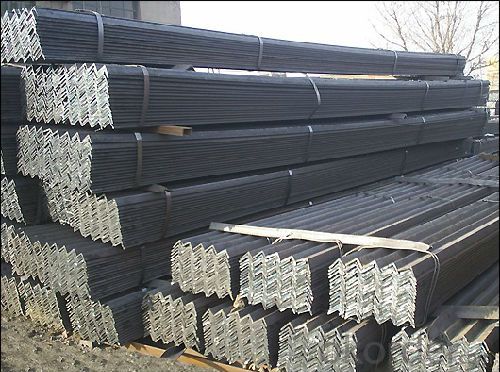
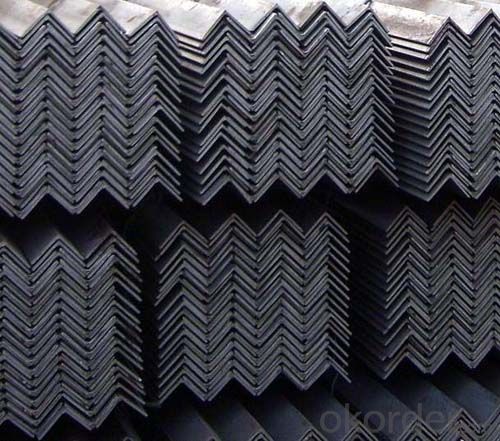
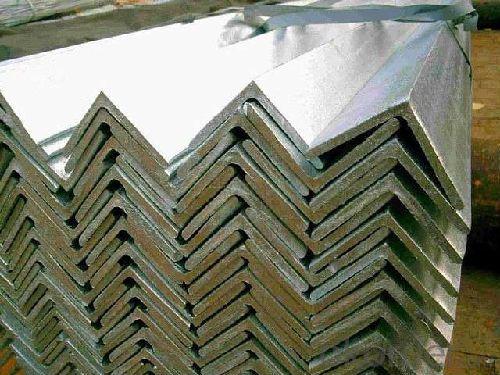
- Q: What are the different corrosion protection methods for steel angles?
- There are several corrosion protection methods for steel angles, including galvanization, powder coating, paint coating, and epoxy coating.
- Q: What are the different uses for stainless steel angles?
- Stainless steel angles find widespread application in diverse industries and fields. Here are several examples of the different ways in which stainless steel angles are utilized: 1. For structural support: In construction and engineering projects, stainless steel angles serve as essential elements for providing stability, strength, and longevity. They are ideal for framing structures, supporting beams, and reinforcing load-bearing structures. 2. In architecture: Stainless steel angles are commonly employed in architectural designs to create decorative trims, frames, and accents. They add aesthetic appeal to buildings, bridges, and other structures. 3. In industrial equipment: Stainless steel angles play a crucial role in the manufacturing and assembly of industrial machinery, conveyor systems, and robotics. They provide stability and reinforcement in heavy-duty applications. 4. In furniture and shelving: Stainless steel angles are frequently used in the construction of furniture and shelving units. They offer stability and support, ensuring long-lasting durability for tables, chairs, storage racks, and display shelves. 5. In the automotive industry: Stainless steel angles find various applications in the automotive sector. They are commonly used in the production of frames, chassis, brackets, and suspension components, offering strength and resistance to corrosion. 6. In marine applications: Due to their resistance to corrosion, stainless steel angles are highly suitable for marine environments. They are commonly used in boat building, ship fittings, and offshore structures, enduring harsh saltwater conditions. 7. In the food processing and medical industries: Stainless steel angles are extensively utilized in the food processing and medical sectors. They are corrosion-resistant, easy to clean, and comply with strict hygiene standards. Stainless steel angles are commonly found in the construction of food processing equipment, surgical instruments, and medical devices. 8. In decorative and artistic projects: Stainless steel angles contribute to artistic and decorative endeavors. Sculptors, designers, and metalworkers often employ them to create visually appealing structures, sculptures, and installations. To summarize, stainless steel angles serve multiple purposes in industries such as construction, architecture, industrial manufacturing, automotive, marine, furniture, food processing, medical, and art. Their strength, durability, and resistance to corrosion make them a versatile and dependable choice in various settings.
- Q: Can steel angles be used for support structures in stadiums or arenas?
- Yes, steel angles can be used for support structures in stadiums or arenas. Steel angles are commonly used in construction and engineering projects due to their strength, durability, and versatility. They are often utilized in structural applications where load-bearing support is required, making them suitable for supporting the weight of stadium or arena structures. Steel angles can be used as beams, columns, or trusses to provide the necessary support and stability for large structures. Their ability to withstand heavy loads and resist bending or warping makes them a popular choice for constructing stadium roofs, grandstands, and other support systems. Additionally, steel angles can be easily fabricated and customized to meet specific design requirements, allowing for efficient and cost-effective construction of stadium and arena support structures.
- Q: What are the common standards and specifications for steel angles?
- Different applications and countries have varying common standards and specifications for steel angles. Notably, the following recognized standards and specifications exist: 1. ASTM A36/A36M: This standard pertains to carbon structural steel, encompassing steel angles, as well as channels and beams. It outlines the chemical composition, mechanical properties, and other essential requirements. 2. ASTM A529/A529M: This specification focuses on high-strength carbon-manganese steel shapes, including angles, used in construction. It specifies chemical composition, mechanical properties, and other significant characteristics. 3. ASTM A572/A572M: Encompassing high-strength low-alloy structural steel shapes, this specification includes angles for construction applications. It delineates the chemical composition, mechanical properties, and other relevant requirements. 4. EN 10056: A European standard, EN 10056, specifies tolerances on shape, dimensions, and mass for hot-rolled structural steel equal and unequal angles. It also outlines chemical composition, mechanical properties, and other characteristics. 5. JIS G3192: This Japanese industrial standard defines dimensions, mass, and tolerances for hot-rolled steel sections, including angles. It establishes requirements for chemical composition, mechanical properties, and other pertinent specifications. These examples demonstrate a fraction of the frequently employed standards and specifications for steel angles. To ensure compliance and meet desired requirements, it is crucial to consult the specific regulations and standards applicable to the region and application.
- Q: How are steel angles used in construction?
- Steel angles are commonly used in construction to provide structural support and stability. They are often used as braces, struts, or beams to reinforce the framework of buildings, bridges, and other structures. Steel angles can also be used as corner supports, especially in the construction of walls and ceilings. Their versatility and strength make them an essential component in various construction applications.
- Q: How do steel angles contribute to the sustainability of a city?
- The sustainability of a city is greatly enhanced by the presence of steel angles, which offer numerous benefits. Firstly, steel angles are essential in the construction industry, as they are utilized in the fabrication of buildings, bridges, and other infrastructure. Steel is renowned for its strength, durability, and ability to withstand external factors like corrosion and fire. With the use of steel angles in construction projects, cities can guarantee the longevity and safety of their structures, thereby reducing the need for frequent maintenance or replacement. This results in a significant reduction in resource consumption over time, thus enhancing the city's sustainability. Moreover, steel angles provide architects and engineers with design flexibility, enabling the creation of innovative and efficient structures. Their versatility allows for the construction of sustainable buildings that incorporate energy-efficient designs, natural lighting, and effective insulation. By incorporating steel angles into the construction process, cities can actively promote sustainable practices and decrease energy consumption, consequently contributing to a more sustainable urban environment. Furthermore, steel is a highly recyclable material, boasting a recycling rate of approximately 90%. By integrating steel angles into construction projects, cities can actively participate in a circular economy by promoting the recycling and reuse of steel products. This practice reduces the demand for raw materials and minimizes waste, thereby lessening the environmental impact of construction projects. The utilization of recycled steel also aids in energy conservation and the reduction of greenhouse gas emissions associated with the production of new steel. In conclusion, the inclusion of steel angles plays a pivotal role in fostering the sustainability of a city. These angles provide durable and long-lasting structures, facilitate energy-efficient designs, and encourage the recycling and reuse of materials. By embracing steel angles in construction projects, cities can establish sustainable infrastructure that positively impacts the environment and the community as a whole.
- Q: Can steel angles be used in curtain wall systems?
- Certainly, curtain wall systems can incorporate steel angles. Typically, in such systems, steel angles function as support brackets or mullions. These angles offer structural stability and reinforcement for the glass panels or other types of cladding materials. It is possible to customize the sizes and shapes of steel angles to suit the specific design needs of the curtain wall system. Moreover, welding or bolting steel angles together allows for the creation of the desired framework for the curtain wall. In conclusion, steel angles present a robust and dependable choice for integration into curtain wall systems.
- Q: Are steel angles resistant to chemicals?
- Yes, steel angles are generally resistant to chemicals due to their high durability and corrosion resistance. However, their resistance may vary depending on the specific type of chemical and environment they are exposed to.
- Q: Can steel angles be used in the construction of storage tanks?
- Yes, steel angles can be used in the construction of storage tanks. Steel angles are commonly used in the construction industry due to their strength, durability, and versatility. In the case of storage tanks, steel angles can be used as structural components to provide support and stability to the tank's framework. They are often used to create the framework for the tank's walls, roof, and base, ensuring the tank's overall strength and stability. Additionally, steel angles can also be used to reinforce corners and joints, improving the tank's structural integrity. Overall, steel angles are a reliable and cost-effective option for incorporating into the construction of storage tanks.
- Q: Can steel angles be used in playground or recreational equipment?
- Absolutely! Playground or recreational equipment can definitely make use of steel angles. Steel angles are incredibly versatile and sturdy as a structural material, making them perfect for a wide range of purposes in playground or recreational equipment. They offer stability, support, and long-lasting durability, which makes them ideal for use in various structures like climbing frames, swing sets, slides, and other equipment. Given their ability to withstand heavy loads, impact forces, and even harsh weather conditions, steel angles are often used to create frames, posts, and supports in playground equipment. What's great is that these angles can be easily customized and fabricated to meet specific design requirements, ensuring that the equipment is both safe and functional.
Send your message to us
Hot rolled sheet Equal Steel Angle bar EN10056
- Loading Port:
- Tianjin
- Payment Terms:
- TT or LC
- Min Order Qty:
- 25 m.t.
- Supply Capability:
- 100000 m.t./month
OKorder Service Pledge
OKorder Financial Service
Similar products
Hot products
Hot Searches
Related keywords



